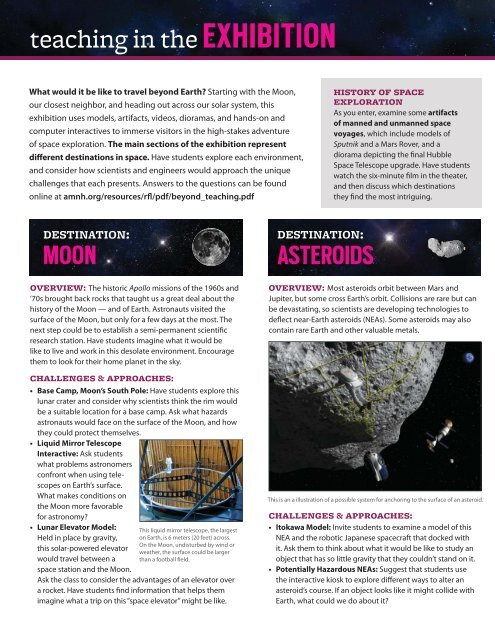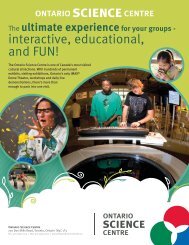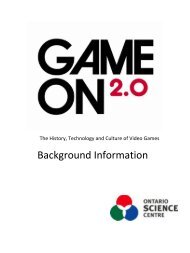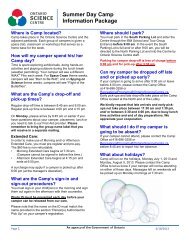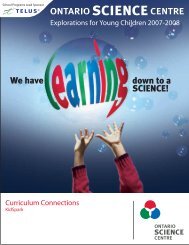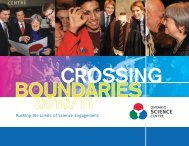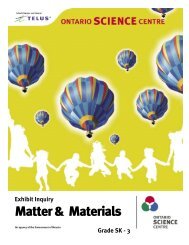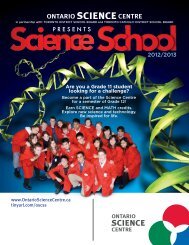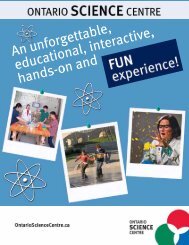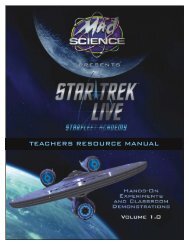Educator's Guide - Ontario Science Centre
Educator's Guide - Ontario Science Centre
Educator's Guide - Ontario Science Centre
Create successful ePaper yourself
Turn your PDF publications into a flip-book with our unique Google optimized e-Paper software.
teaching in the EXHIBITION<br />
What would it be like to travel beyond Earth Starting with the Moon,<br />
our closest neighbor, and heading out across our solar system, this<br />
exhibition uses models, artifacts, videos, dioramas, and hands-on and<br />
computer interactives to immerse visitors in the high-stakes adventure<br />
of space exploration. The main sections of the exhibition represent<br />
different destinations in space. Have students explore each environment,<br />
and consider how scientists and engineers would approach the unique<br />
challenges that each presents. Answers to the questions can be found<br />
online at amnh.org/resources/rfl/pdf/beyond_teaching.pdf<br />
history of space<br />
exploration<br />
As you enter, examine some artifacts<br />
of manned and unmanned space<br />
voyages, which include models of<br />
Sputnik and a Mars Rover, and a<br />
diorama depicting the final Hubble<br />
Space Telescope upgrade. Have students<br />
watch the six-minute film in the theater,<br />
and then discuss which destinations<br />
they find the most intriguing.<br />
overview: The historic Apollo missions of the 1960s and<br />
‘70s brought back rocks that taught us a great deal about the<br />
history of the Moon — and of Earth. Astronauts visited the<br />
surface of the Moon, but only for a few days at the most. The<br />
next step could be to establish a semi-permanent scientific<br />
research station. Have students imagine what it would be<br />
like to live and work in this desolate environment. Encourage<br />
them to look for their home planet in the sky.<br />
challenges & approaches:<br />
• Base Camp, Moon’s South Pole: Have students explore this<br />
lunar crater and consider why scientists think the rim would<br />
be a suitable location for a base camp. Ask what hazards<br />
astronauts would face on the surface of the Moon, and how<br />
they could protect themselves.<br />
• Liquid Mirror Telescope<br />
Interactive: Ask students<br />
what problems astronomers<br />
confront when using telescopes<br />
on Earth’s surface.<br />
What makes conditions on<br />
the Moon more favorable<br />
for astronomy<br />
• Lunar Elevator Model:<br />
Held in place by gravity,<br />
this solar-powered elevator<br />
would travel between a<br />
space station and the Moon.<br />
Ask the class to consider the advantages of an elevator over<br />
a rocket. Have students find information that helps them<br />
imagine what a trip on this “space elevator” might be like.<br />
This liquid mirror telescope, the largest<br />
on Earth, is 6 meters (20 feet) across.<br />
On the Moon, undisturbed by wind or<br />
weather, the surface could be larger<br />
than a football field.<br />
overview: Most asteroids orbit between Mars and<br />
Jupiter, but some cross Earth’s orbit. Collisions are rare but can<br />
be devastating, so scientists are developing technologies to<br />
deflect near-Earth asteroids (NEAs). Some asteroids may also<br />
contain rare Earth and other valuable metals.<br />
This is an a illustration of a possible system for anchoring to the surface of an asteroid.<br />
challenges & approaches:<br />
• Itokawa Model: Invite students to examine a model of this<br />
NEA and the robotic Japanese spacecraft that docked with<br />
it. Ask them to think about what it would be like to study an<br />
object that has so little gravity that they couldn’t stand on it.<br />
• Potentially Hazardous NEAs: Suggest that students use<br />
the interactive kiosk to explore different ways to alter an<br />
asteroid’s course. If an object looks like it might collide with<br />
Earth, what could we do about it


